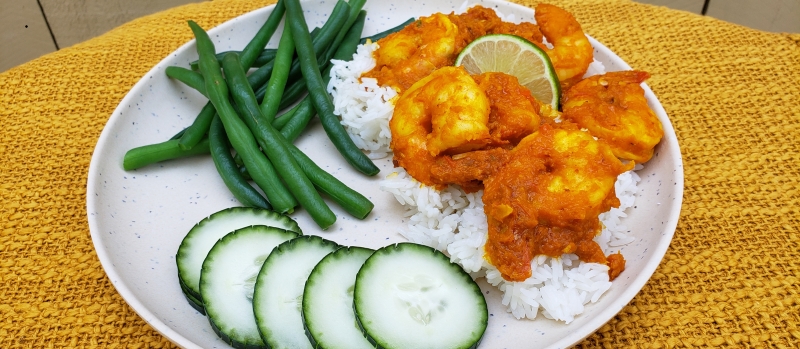
Udang Balado is a spicy shrimp curry from the Minangkabau region of Indonesia. Hot and spicy, this easy-to-prepare dish is sure to become a favorite you will long for.
West Sumatra Indonesia is home to the Minangkabau, the world's largest matrilineal society. In addition to having a unique family system where everyone belongs to their mother's clan (not their father's) and where husbands typically move to their wife's ancestral home, the Minangkabau are also very devoted Muslims. My wife and I (and for 1 year our daughter) spent nearly three years in West Sumatra engaged in anthropological research (ok, not our daughter, her role was to play a spirited and endearing 3-year-old). Due to the incredible good will of the people of Kamang (where we lived), it was as close to paradise for us as one could even imagine. It's a very heady feeling to have an entire village have your best interests in mind. We will be forever grateful.
The word "balado" is the Minangkabau adjective (Minangkabau might be the closest language to "bahasa Indonesia", the national language) that means "with chili" and there are many dishes that fall under this category. My absolute favorite is maco balado (pronounced 'macho baalaado'), a hot chili-based dish made with tiny little dried fish called, not surprisingly, maco. Every culture has its perfunctory ways of greeting people along the road, and in Minangkabau, the pattern is as follows: Q: "Where are you going?" A: "To the market", Q: "What are you going to buy?" A: "I'm going to buy maco." And that is all that is minimally required to continue on your way. Maco balado differs from Udang Balado because the latter has more of a sauce made from a variety of ingredients while maco balado is basically fried dried fish with chilies. As such, even at is incendiary hottest, it is a bit milder.
Indonesian typically eat with their right hand, sans utensils (unless they are eating soup). It is proper and usual etiquette to symbolically offer your food to others if you are in a restaurant by looking at the people closest to you, softly lifting both hands, palms up (as if you were giving somebody something, but the movement of your hands is only vertical) and saying "Makanlah!". "Makan" translates as "food" or "eating" and attaching "lah" to the end of a verb most of the time means "let's", so "makanlah" means "let's eat!". The trick to eating Indonesian food with your hands is to use your fingers to mix a bit of the dish you are eating with some rice and then "pop" the result in your mouth avoiding touching your lips with your fingers. It takes a bit of practice, but it is undoubtedly one of the most pleasurable ways of eating. Needless to say, kids love it too.
Only a few of the ingredients are specialty items, but you can make a fine udang balado without them. "Bumbu" is the typical word for a cooking paste in Indonesia. Bumbu gado-gado (our very first recipe of the month) is the paste for gado-gado. Bumbu udang balado is a paste made from shallots, garlic, candlenut, ginger, shrimp paste, turmeric, galangal and red chili peppers. You can find the candlenut, shrimp paste and fresh galangal root (I find the dried powered version a bit on the bitter side) at 99 Ranch Market. All the rest of the ingredients can be found in just about any supermarket or larger grocery store. The dish can also be improved by the addition of fresh lemongrass, citrus leaves (daun jeruk) and coconut oil for cooking.
Udang Balado can be cooked and served with either shelled or unshelled shrimp. However, to retain the most shrimp flavor, it is best to begin by frying the shrimp in their shells, peeling them afterwards. This dish, like so many other dishes combines the flavors of sweet, salty, spicy, sour and (sometimes) bitter. Some recipes include finely cubed potatoes, hard-boiled eggs cut in half and green beans or "long beans" (kacang panjang). Minangkabau and other Indonesians typically enjoy their meals with a glass of hot water or, occasionally, hot tea. Limeade, ginger beer or beer are also nice complements, but hot water or tea are more common at meals in Indonesia.
Ingredients:
- 1 pound medium large shrimp.
- 2 tablespoons of coconut oil (or substitute a neutral-tasting oil)
- 4 kaffir lime leaves (optional)
Bumbu ingredients:
- 2 teaspoons terasi or belacan shrimp paste (optional, can be bought via Amazon). Another kind of shrimp paste can be used (such as Thai shrimp paste) but the flavor will be different.
- 3 shallots
- 2 tablespoons fresh lime juice
- 1 Roma tomato (1/2 cup of canned tomato can be substituted). Many udang balado recipes don't include tomato.
- 8 Thai or birds-eye chilies chopped very fine. Use gloves and perhaps eye protection. The easy and indeed common way is to use Indonesian sabal olek chili sauce which now can be found in major grocery stores.
- 1 teaspoon cane sugar (or palm sugar if you have it!)
- 2 teaspoons salt (less if using balacan or terasi shrimp paste which are both salty)
- 4 ground candlenuts (optional)
- 1 stalk of crushed lemongrass. Bruise or crush the white part of the lemongrass with a kitchen hammer or the blunt edge of a large knife. You can remove the green part and discard. (dried chopped lemongrass may be used but it is
- inferior in taste).
- 1 2-inch piece of peeled galangal root (may substitute with ginger or use both)
- 2 teaspoons powdered turmeric or for a richer color and taste, find fresh turmeric.
Preparation:
- In a food processor (or go old school with a mortar and pestle), grind into a smooth paste the chilies (or sambal olek), tomato lime juice, salt, sugar, shallots, turmeric and shrimp paste.
- Lightly fry the shrimp in some coconut oil and then remove or retain the shells (note: you will finish cooking the shrimp after you fry the bumbu)
- Add the bumbu, lime leaves, crushed lemongrass stalk, ground candlenut to 2 tablespoons of coconut oil to a frying pan set on medium and fry until everything is fragrant (about 3-5 minutes).
- Add the shrimp, turn continually until the shrimp is thoroughly cooked and well-coated with sauce.
- Serve with boiled green beans (or long-beans!) and rice.
Silakan Makan!
Recipe and photos: T. Johnston-O’Neill









